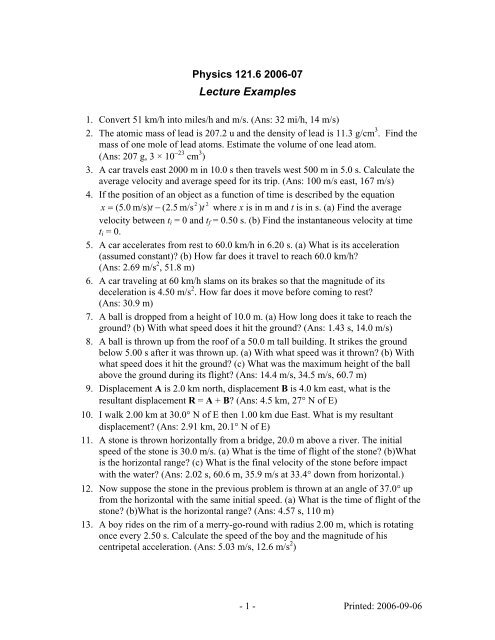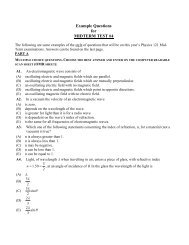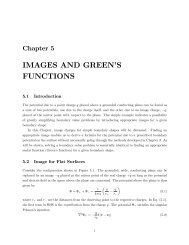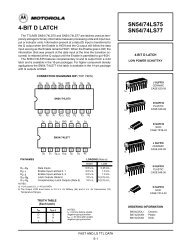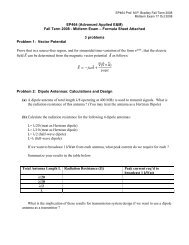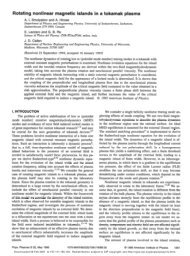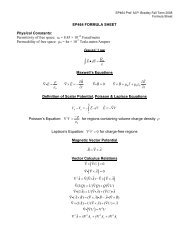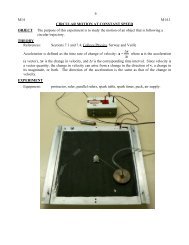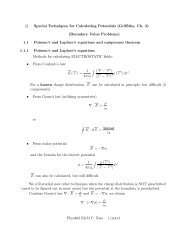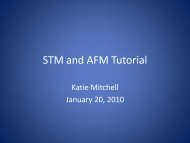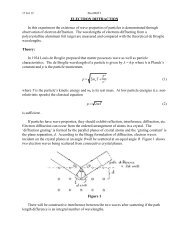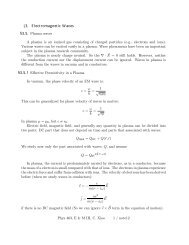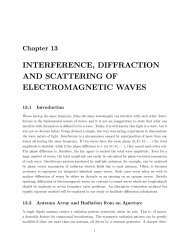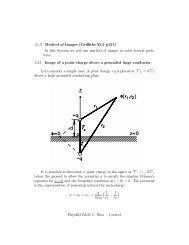Lecture Examples - Department of Physics and Engineering Physics
Lecture Examples - Department of Physics and Engineering Physics
Lecture Examples - Department of Physics and Engineering Physics
Create successful ePaper yourself
Turn your PDF publications into a flip-book with our unique Google optimized e-Paper software.
<strong>Physics</strong> 121.6 2006-07<strong>Lecture</strong> <strong>Examples</strong>1. Convert 51 km/h into miles/h <strong>and</strong> m/s. (Ans: 32 mi/h, 14 m/s)2. The atomic mass <strong>of</strong> lead is 207.2 u <strong>and</strong> the density <strong>of</strong> lead is 11.3 g/cm 3 . Find themass <strong>of</strong> one mole <strong>of</strong> lead atoms. Estimate the volume <strong>of</strong> one lead atom.(Ans: 207 g, 3 × 10 −23 cm 3 )3. A car travels east 2000 m in 10.0 s then travels west 500 m in 5.0 s. Calculate theaverage velocity <strong>and</strong> average speed for its trip. (Ans: 100 m/s east, 167 m/s)4. If the position <strong>of</strong> an object as a function <strong>of</strong> time is described by the equation2x = ( 5.0 m/s) t − (2.5 m/s 2 ) t where x is in m <strong>and</strong> t is in s. (a) Find the averagevelocity between ti = 0 <strong>and</strong> t f = 0.50 s. (b) Find the instantaneous velocity at timet i = 0.5. A car accelerates from rest to 60.0 km/h in 6.20 s. (a) What is its acceleration(assumed constant)? (b) How far does it travel to reach 60.0 km/h?(Ans: 2.69 m/s 2 , 51.8 m)6. A car traveling at 60 km/h slams on its brakes so that the magnitude <strong>of</strong> itsdeceleration is 4.50 m/s 2 . How far does it move before coming to rest?(Ans: 30.9 m)7. A ball is dropped from a height <strong>of</strong> 10.0 m. (a) How long does it take to reach theground? (b) With what speed does it hit the ground? (Ans: 1.43 s, 14.0 m/s)8. A ball is thrown up from the ro<strong>of</strong> <strong>of</strong> a 50.0 m tall building. It strikes the groundbelow 5.00 s after it was thrown up. (a) With what speed was it thrown? (b) Withwhat speed does it hit the ground? (c) What was the maximum height <strong>of</strong> the ballabove the ground during its flight? (Ans: 14.4 m/s, 34.5 m/s, 60.7 m)9. Displacement A is 2.0 km north, displacement B is 4.0 km east, what is theresultant displacement R = A + B? (Ans: 4.5 km, 27° N <strong>of</strong> E)10. I walk 2.00 km at 30.0° N <strong>of</strong> E then 1.00 km due East. What is my resultantdisplacement? (Ans: 2.91 km, 20.1° N <strong>of</strong> E)11. A stone is thrown horizontally from a bridge, 20.0 m above a river. The initialspeed <strong>of</strong> the stone is 30.0 m/s. (a) What is the time <strong>of</strong> flight <strong>of</strong> the stone? (b)Whatis the horizontal range? (c) What is the final velocity <strong>of</strong> the stone before impactwith the water? (Ans: 2.02 s, 60.6 m, 35.9 m/s at 33.4° down from horizontal.)12. Now suppose the stone in the previous problem is thrown at an angle <strong>of</strong> 37.0° upfrom the horizontal with the same initial speed. (a) What is the time <strong>of</strong> flight <strong>of</strong> thestone? (b)What is the horizontal range? (Ans: 4.57 s, 110 m)13. A boy rides on the rim <strong>of</strong> a merry-go-round with radius 2.00 m, which is rotatingonce every 2.50 s. Calculate the speed <strong>of</strong> the boy <strong>and</strong> the magnitude <strong>of</strong> hiscentripetal acceleration. (Ans: 5.03 m/s, 12.6 m/s 2 )- 1 - Printed: 2006-09-06
<strong>Physics</strong> 121.6 2005-06 <strong>Lecture</strong> <strong>Examples</strong>24. A mass <strong>of</strong> 0.300 kg is swung around in a horizontal circle at the end <strong>of</strong> a 1.20 mlong piece <strong>of</strong> string. The angle between the string <strong>and</strong> the horizontal is 6.00°.(a) What is the tension in the string <strong>and</strong> (b) what is the period <strong>of</strong> the motion?(Ans: 28.1 N, 0.709 s)25. A car drives around a 45 m radius curve which is banked at an angle <strong>of</strong> 20°. Whatis the speed <strong>of</strong> the car so that there is no sideways friction force on the tires?(Ans: 13 m/s)26. A roller-coaster car goes around a vertical circular loop-the-loop with a diameter<strong>of</strong> 50.0 m. Ignoring friction, what is the minimum speed <strong>of</strong> the car at the top <strong>of</strong> theloop so that the car stays in contact with the track? (Ans: 15.7 m/s = 56 km/h)27. Find an expression for the terminal velocity <strong>of</strong> a solid sphere falling through theair. How does the terminal velocity depend on the density <strong>and</strong> radius <strong>of</strong> thesphere?28. A man raises a 3.0 kg mass to a height <strong>of</strong> 2.0 m at a constant speed. (a) What is thework done by the man on the mass? (b) What is the work done by the force <strong>of</strong>gravity on the mass? (c) What is the work done by the net force on the mass?(Ans: (a) 59 J, (b) −59 J, (c) 0)29. A block is pulled along a horizontal surface with a force <strong>of</strong> 10 N which is appliedat an angle <strong>of</strong> 30° to the horizontal. The block moves 2.0 m along the surface.What is the work done on the block by the force? (Ans: 17 J)30. Consider the vectors a = 3 ˆi+ 2ˆj<strong>and</strong> b = 2 ˆi+ 4ˆj. What is the angle between a <strong>and</strong>b? (Ans: 29.8°)31. When a mass <strong>of</strong> 0.200 kg is hung from the end <strong>of</strong> a vertically suspended spring,the spring is stretched by 10.0 cm. What is the spring constant <strong>of</strong> the spring?(Ans: 19.6 N/m)32. A box, <strong>of</strong> mass 4.0 kg, slides down a frictionless incline, which is at an angle <strong>of</strong>30° to the horizontal. It slides a distance <strong>of</strong> 2.5 m. (a) What is the net work done onthe box as it slides? (b) If the box starts from rest, what is its final speed?(Ans: 49 J, 4.9 m/s)33. A box <strong>of</strong> mass 30.0 kg slides down a ramp. It starts from rest <strong>and</strong> reaches a speed<strong>of</strong> 5.00 m/s at the bottom. In that time it moves down a vertical distance <strong>of</strong> 3.00 m<strong>and</strong> across a horizontal distance <strong>of</strong> 4.00 m. (a) Find the work done by the frictionforce on the box. (b) Find the magnitude <strong>of</strong> the force <strong>of</strong> friction between the ramp<strong>and</strong> the box. (Ans: −507 N, 101 N)34. A car moving at a speed <strong>of</strong> 50.0 km/h slams on its brakes <strong>and</strong> skids to rest. If thecoefficient <strong>of</strong> kinetic friction between the tires <strong>and</strong> the road is 0.500, what is thestopping distance? (Ans: 19.7 m)35. A car delivers 100 hp to the wheels. The mass <strong>of</strong> the car <strong>and</strong> driver is 1800 kg. Ifthe car starts from rest on level ground, <strong>and</strong> the power is constant, what is thespeed <strong>of</strong> the car after 2.0 s <strong>and</strong> after 4.0 s? (Ignore any energy lost to friction.)(Ans: 13 m/s, 18 m/s)36. A brick is dropped from a height <strong>of</strong> 4.0 m. Ignoring air resistance, with what speeddoes it hit the ground? (Ans: 8.9 m/s)- 3 - Printed: 2006-09-06
<strong>Physics</strong> 121.6 2005-06 <strong>Lecture</strong> <strong>Examples</strong>37. A roller-coaster car starts from rest at a height h<strong>and</strong> goes around a vertical loop-the-loop <strong>of</strong>diameter d as shown. Ignoring friction, find theminimum height h so that the car remains inhd5dcontact with the track. (Ans: h = )438. A mass <strong>of</strong> 1.00 kg is dropped from a heightabove the floor <strong>of</strong> 80.0 cm onto a spring, <strong>of</strong>unstretched length <strong>of</strong> 20.0 cm, which is restingon the floor. It comes to rest, momentarily, at aheight <strong>of</strong> 10.0 cm from the floor. If we canignore friction, find the spring constant <strong>of</strong> thespring. (Ans: 1.37 × 10 3 N/m)39. An elevator, with mass 1000 kg, carries a load<strong>of</strong> 800 kg. It moves up with a constant speed <strong>of</strong>3.00 m/s <strong>and</strong> there is constant friction force <strong>of</strong>4000 N on the elevator. What is the power that the motor must deliver?(Ans: 64.9 kW)40. A cannon with mass 600 kg fires a cannonball with mass 2.0 kg. The muzzle speed<strong>of</strong> the cannonball is 20 m/s. What is the recoil speed <strong>of</strong> the cannon?(Ans: 6.7 × 10 –2 m/s)41. A ball <strong>of</strong> putty, with mass 0.20 kg is thrown towards a wall with a speed <strong>of</strong> 16 m/s.It sticks to the wall <strong>and</strong> the duration <strong>of</strong> the collision is 0.70 s. What is the impulseon the ball? What is the average force on the ball? (Ans: –3.20 kg.m/s, –4.6 N)42. A 20,000 kg truck collides head on with a 1500 kg car. The speed <strong>of</strong> the truck is5.0 m/s (18 km/h) <strong>and</strong> the speed <strong>of</strong> the car is 8.0 m/s (29 km/h). After the collisionthe two vehicles stick together. (a) What is the speed <strong>of</strong> the wreck after thecollision? (b) If each driver has a mass <strong>of</strong> 100 kg <strong>and</strong> the duration <strong>of</strong> the collisionis 0.20 s what is the average magnitude force on each driver? (Ans: 4.1 m/s, truckdriver 4.5 × 10 2 N, car driver 6.1 × 10 3 N)43. A ball <strong>of</strong> mass m moving in the +x direction on a frictionless surface, collideshead-on with a stationary ball <strong>of</strong> mass 2m. After the collision the ball with mass2m is moving in the +x direction with speed 2.00 m/s. The collision is elastic. Findthe initial <strong>and</strong> final velocity <strong>of</strong> the ball with mass m. (Ans: +3.00 m/s, −1.00 m/s)44. A ball <strong>of</strong> mass 0.20 kg travels in the +x direction with speed 5.0 m/s. It collides,head on, with a stationary ball <strong>of</strong> mass 0.30 kg. The collision is elastic. Find thevelocities <strong>of</strong> the balls after the collision. (Ans: –1.0 m/s, +4.0 m/s)45. A billiard ball hits a stationary billiard ball. (The balls have equal mass.) After thecollision the first ball moves at an angle <strong>of</strong> 30° to its original direction at a speed<strong>of</strong> 1.0 m/s. The other ball moves at an angle <strong>of</strong> 60° to the original direction <strong>of</strong> thefirst ball. Find the original speed <strong>of</strong> the first ball <strong>and</strong> the speed <strong>of</strong> the second ballafter the collision. (Ans: 1.2 m/s, 0.58 m/s)46. A mass <strong>of</strong> 2.0 kg is at the origin <strong>and</strong> a mass <strong>of</strong> 5.0 kg is at x = 2.0 m. Find theposition <strong>of</strong> the centre <strong>of</strong> mass <strong>of</strong> this system. (Ans: x = 1.4 m)80.0 cm20.0 cm10.0 cm- 4 - Printed: 2006-09-06
<strong>Physics</strong> 121.6 2005-06 <strong>Lecture</strong> <strong>Examples</strong>56. A circular object, with radius 0.100 m, rolls without slipping down a ramp. It startfrom rest <strong>and</strong> after rolling to the bottom, a distance <strong>of</strong> 3.00 m down the ramp, ithas a speed <strong>of</strong> 2.00 m/s. (a) Find its angular speed at the bottom. (b) How manyrevolutions did the object make to reach the bottom? (c) Calculate the angularacceleration <strong>of</strong> the object about its centre as it rolls. (Ans: 20.0 rad/s, 4.77 rev,6.67 rad/s 2 )57. A sphere, a cylinder <strong>and</strong> a hoop, roll, without slipping, from the same height downa ramp. Which reaches the bottom first?58. An object <strong>of</strong> mass 3.0 kg is moving with speed 1.5 m/s in the +x direction alongthe y = 2.0 m line. Calculate the angular momentum <strong>of</strong> the object about the origin.(Ans: 9.0 kg.m 2 /s in the −z direction)59. A light rod with two masses attached to its ends, rotates horizontally about avertical axis that passes through the center <strong>of</strong> the rod. The length <strong>of</strong> the rod is1.0 m <strong>and</strong> the masses are 1.0 kg each. The rod <strong>and</strong> masses rotates with an initialangular velocity <strong>of</strong> 8.0 rad/s. An internal mechanism pulls both masses half waytowards the axis <strong>of</strong> rotation. Find the final angular velocity <strong>of</strong> the rod <strong>and</strong> masses.Find the initial <strong>and</strong> final rotational kinetic energies <strong>of</strong> the system. Is kinetic energyconserved? (Ans: 32 rad/s, 16 J, 64 J, no)2.00 m60. A man, with weight 800 N st<strong>and</strong>s on a “light” plank supportedby two ropes attached to the ends <strong>of</strong> the plank. Ignore theweight <strong>of</strong> the plank. The plank has length 5.00 m <strong>and</strong> the manst<strong>and</strong>s 2.00 m from one end. Find the tensions in the ropes.(Ans: 480 N, 320 N)5.00 m61. A uniform bar <strong>of</strong> length 4.0 m <strong>and</strong> mass 10 kg is attached to awall with a hinge. The bar is supported horizontally by a stringwhich is attached to the wall <strong>and</strong> to the free end <strong>of</strong> the bar suchthat the string makes an angle <strong>of</strong> 60º with the bar as shown.Find the tension in the string <strong>and</strong> the reaction force <strong>of</strong> the hingeon the bar. (Ans: 57 N, 57 N at 60º to horizontal)62. What is the radius <strong>of</strong> the orbit <strong>of</strong> a geosynchronous60ºcommunications satellite (in a geostationary orbit)?(Ans: 4.2 × 10 7 m)63. Newton calculated the period <strong>of</strong> the Moon in its orbit around the Earth to comparewith the known period. At that time he knew the radius <strong>of</strong> the Moon’s orbit(3.84 × 10 8 m), but he did not know the Universal Gravitational Constant or themass <strong>of</strong> the Earth. He did know the acceleration due to gravity at the Earth’ssurface (9.80 m/s 2 ) <strong>and</strong> the radius <strong>of</strong> the Earth (6.37 × 10 6 m). How did hecalculate the Moon’s period <strong>and</strong> what answer would he get? (Ans: 27.4 days)64. A projectile, fired straight up from Earth’s surface with initial speed v 0 , reaches amaximum height <strong>of</strong> 3200 km. Neglecting air friction what is v 0 ? What speedwould be needed so the projectile never falls back to Earth? (Ans: 6.47 × 10 3 m/s,1.12 × 10 4 m/s)- 6 - Printed: 2006-09-06
<strong>Physics</strong> 121.6 2005-06 <strong>Lecture</strong> <strong>Examples</strong>77. A certain hearing aid increases the sound intensity level by 30 dB. A person needsa minimum sound intensity <strong>of</strong> 2.0 × 10 –9 W/m 2 to hear without the hearing aid.Can the person hear a whisper <strong>of</strong> intensity 1.0 × 10 –11 W/m 2 while using thehearing aid? (Ans: yes)78. A train whistle, as heard by the engineer in the locomotive, has a frequency <strong>of</strong>800 Hz. A person, st<strong>and</strong>ing near the tracks, hears the whistle <strong>and</strong> notes it has afrequency <strong>of</strong> 760 Hz. What is the speed <strong>of</strong> the train? Is the train approaching orgoing away from the person? (Ans: 18.1 m/s, going away)79. Two speakers emit, in phase, the same frequency <strong>of</strong> 343 Hz. The speakers are10 m apart. A man st<strong>and</strong>s half way between the two speakers. Will the man hearconstructive or destructive interference <strong>of</strong> the two sounds? The man now walkstowards one <strong>of</strong> the speakers. How far will he walk before he reaches a point withminimum sound intensity. (Ans: Constructive, 0.25 m)80. A guitar string has a length <strong>of</strong> 40 cm <strong>and</strong> is under tension <strong>of</strong> 80 N. The string has amass per unit length <strong>of</strong> 200 g/m. What is the speed <strong>of</strong> a wave along this string <strong>and</strong>what frequency sounds will result when the string is plucked? (Ans: 20 m/s, 25 Hz,50 Hz, 75 Hz….)81. A loud speaker is placed over the open end <strong>of</strong> a 2.0 m long pipe. By changing thefrequency <strong>of</strong> the sound from the speaker it is noted that there are many resonantfrequencies. One <strong>of</strong> these is at 280 Hz, <strong>and</strong> the next higher frequency one is at360 Hz. Is the other end <strong>of</strong> the pipe open or closed? Use this information to findthe speed <strong>of</strong> sound in the air in the pipe. (Ans: Closed, 320 m/s)82. A piano tuner strikes middle A (440 Hz). This piano has two stings for this note.He knows that one <strong>of</strong> the strings is tuned to exactly 440 Hz. When both stringssound together he perceives that the note is flat <strong>and</strong> he hears beats with afrequency <strong>of</strong> 2.0 Hz. What is the frequency <strong>of</strong> the second string? (Ans: 438 Hz)83. Find the frequency <strong>of</strong> light that, when it travels in a vacuum, has a wavelength <strong>of</strong>598 nm. What wavelength does this light have when it travels in water? Therefractive index <strong>of</strong> water is 1.33. (Ans: 5.02 × 10 14 Hz, 450 nm)84. Light travels from water into air. The refractive index <strong>of</strong> water is 1.33. If the angle<strong>of</strong> incidence is 30°, find the angle <strong>of</strong> refraction. (Ans: 41.7°)85. Find the critical angles for total internal reflection when light strikes a glass-airboundary <strong>and</strong> when light strikes a diamond-air boundary. The refractive index <strong>of</strong>the glass is 1.50 <strong>and</strong> for diamond it is 2.42. (Ans: 41.8°, 24.4°)86. A paper clip, with height 2.0 cm is placed 25 cm in front <strong>of</strong> a concave mirror witha radius <strong>of</strong> 40.0 cm. Find the location <strong>of</strong> the image, the magnification <strong>of</strong> thesystem <strong>and</strong> the height <strong>of</strong> the image <strong>of</strong> the paper clip. Is the image upright or upsidedown <strong>and</strong> is the image real or virtual? (Ans: +100 cm, –4.0, –8.0 cm, upside down,real)87. A fish appears to be 40 cm below the surface <strong>of</strong> the water. What is the actual depth<strong>of</strong> the fish? (Ans: 53.2 cm)- 8 - Printed: 2006-09-06
<strong>Physics</strong> 121.6 2005-06 <strong>Lecture</strong> <strong>Examples</strong>100. An electron is released from rest in a region where there is a uniform electric field<strong>of</strong> 5000 N/C. What is the speed <strong>of</strong> the electron after it has moved a distance <strong>of</strong>10 cm? (Ans: 1.3 × 10 7 m/s)101. The potential difference between the filament <strong>and</strong> the accelerating electrode in aTV picture tube is 5000 V. What is the kinetic energy <strong>of</strong> an electron acceleratedthrough this potential difference. (Ans: 5 keV = 8.0 × 10 –16 J)102. A –1.0 μC charge is placed a distance <strong>of</strong> 4.0 m to the right <strong>of</strong> a +1.0 μC charge.Calculate the electric field <strong>and</strong> the absolute electric potential at a point A, located1.0 m from the +1.0 μC charge along a line between the two charges, <strong>and</strong> at apoint B midway between the two charges. (Ans: A: 1.0 × 10 4 N/C to right,+6.0 × 10 3 V, B: 4.5 × 10 4 N/C to right, 0 V)103. For the situation described in the previous example, a mass <strong>of</strong> 1.0 μg with charge –2.0 μC is released from rest at point B. What is the mass’s kinetic energy <strong>and</strong>speed when it reaches point A? (Ans: 1.0 × 10 –2 J, 4.9 × 10 3 m/s)104. Calculate the electron drift speed in a copper wire, 1.0 mm in diameter, which iscarrying a current <strong>of</strong> 1.0 A. Assume each copper atom contributes 1 electron thatcan move in the metal. The atomic mass <strong>of</strong> copper is 63.5 g/mole <strong>and</strong> the density<strong>of</strong> copper is 8.95 g/cm 3 . (Ans: 9.4 × 10 −3 cm/s)105. An aluminum wire <strong>of</strong> length 10.0 m <strong>and</strong> diameter 0.500 mm has 50.0 V across itsends. Calculate the current flowing in the wire. The resistivity <strong>of</strong> aluminum is2.83 × 10 –8 Ω⋅m. (Ans: 34.7 A)106. The aluminum wire in the previous example was at a temperature <strong>of</strong> 20°C. Thetemperature coefficient <strong>of</strong> resistivity for aluminum is 0.0039 °C −1 . What is thecurrent in the wire when the temperature is raised to 50°C? (Ans: 31.1 A)107. Consider a 100 W set <strong>of</strong> Christmas lights which are run from a voltage source <strong>of</strong>120 V. What is the current through the lights <strong>and</strong> what is the total resistance <strong>of</strong> thelights? How much does it cost to have the lights turned on for 8 hours per day for 4weeks at a rate <strong>of</strong> 9 cents/kw-hr? (Ans: 0.83 A, 144 Ω, $2.02)108. A battery has an open circuit voltage <strong>of</strong> 15.0 V. When a load resistance <strong>of</strong> 2.00 Ωis connected to it, 72.0 W is delivered to the load. (a) Find the internal resistance<strong>of</strong> the battery. (b) Find the terminal voltage <strong>of</strong> the battery. (Ans: 0.500 Ω, 12.0 V)109. An equivalent circuit for a carbattery which is connected to theSwitchhead-lights <strong>and</strong> is connected via ar = 0.10 Ωswitch to the starter motor, is shownin the diagram. With the starterswitch (a) open <strong>and</strong> (b) closed:(i) Find the power delivered to thelights. (ii) Find the terminal voltage<strong>of</strong> the battery. (Ans: 65 W, 11.4 V,38 W, 8.7 V)Batteryε = 12 VLightsStarter R 2 = 2.0 ΩMotorR 1 = 0.30 Ω- 10 - Printed: 2006-09-06
<strong>Physics</strong> 121.6 2005-06 <strong>Lecture</strong> <strong>Examples</strong>110. In the circuit shown, find the currents through theresistances R 1 , R 2 <strong>and</strong> R 3 <strong>and</strong> find the potentialdifference <strong>of</strong> point B with respect to point A.(Ans: 0.400 A, −0.133 A, 0.267 A, +8.00 V)R 1 = 10 ΩBR 2 = 15 ΩR 3 = 30 Ω111. A 1000 W toaster is run from an alternatingvoltage source rated at 120 V (rms). What is therms current through the toaster? What is theresistance <strong>of</strong> the toaster? What is the peak currentthrough the toaster? (Ans: 8.33 A, 14.4 Ω, 11.8 A)ε 1 = 12 VAε 2 = 6 V112. Find the force on a proton, with kinetic energy 10 keV, that ismoving perpendicular to a magnetic field <strong>of</strong> magnitude2.0 kG. (Ans: 4.4 × 10 –14 N)v113. A loop <strong>of</strong> wire is partially in a region <strong>of</strong>uniform magnetic field <strong>of</strong> magnitudeB = 0.60 T as shown in the diagram. Thewidth <strong>of</strong> the loop L is 2.0 cm <strong>and</strong> thecurrent flowing in the loop is I = 3.0 A.Find the net force on the loop <strong>of</strong> wire.(Ans: 3.6 × 10 −2 N to right)BLI114. A beam <strong>of</strong> electrons is moving in a horizontal circle in a uniform magnetic fieldthat is directed downward. The speed <strong>of</strong> the electrons is 1.0 × 10 7 m/s <strong>and</strong> themagnitude <strong>of</strong> the magnetic field is 1.0 × 10 –3 T. (a) As seen from above, are theelectrons moving clockwise or counter clockwise? (b) What is the radius <strong>of</strong> theelectron’s orbit? (c) What is the period <strong>of</strong> their motion? (Ans: clockwise, 5.7 cm,3.6 × 10 –8 s)115. A velocity selector consists <strong>of</strong> a region <strong>of</strong> space where there is a magnetic field<strong>and</strong> an electric field. The E <strong>and</strong> B vectors are perpendicular to each other. Thereare collimators at either end <strong>of</strong> this region <strong>of</strong>space so that only charged particles that travel inBa straight line can make it through. Only oneEvvelocity <strong>of</strong> the charged particle has a trajectory qthat is a straight line. Find that velocity if themagnitude <strong>of</strong> the electric field is 9.3 × 10 5 V/m<strong>and</strong> the magnitude <strong>of</strong> the magnetic field is0.40 T. (Ans: 2.3 × 10 6 m/s)- 11 - Printed: 2006-09-06


